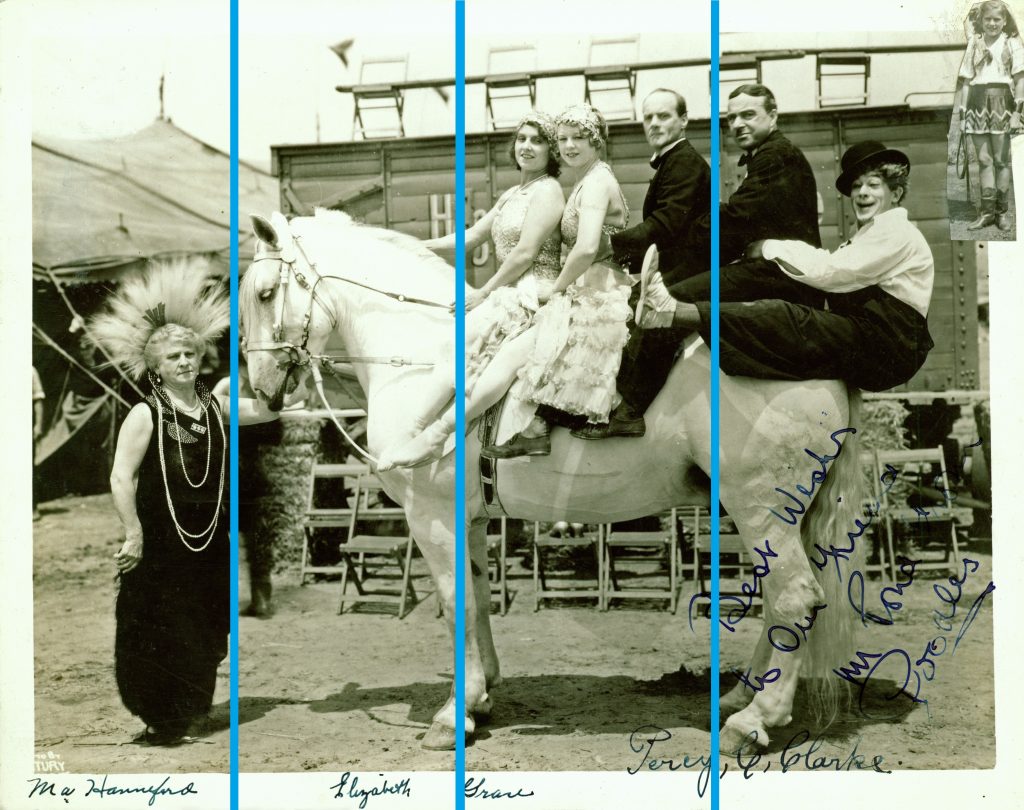Curriculum connection: Community, Family, Work
From the American Circus Collection of Irving Kane Pond at the Newberry Library.
Materials – Available for Download in the Downloads Tab:
- A copy of “The Clarke-Hanneford Family” lesson
- A high-resolution copy of the edited image for older students
- Student worksheet for this lesson
You and your students will examine this photograph of the Clarke-Hanneford family circus performers.
To make sure your students are clear about the difference between photographs and drawings, paintings, or other forms of illustration, you may want to review the Skills Lesson: Types of Photographs.
Click on the photograph below for a high-resolution version to display in class.
For Younger Students
Display the photograph. Begin by explaining that the photograph was taken behind the scenes at a circus. It is a picture they gave away to fans.
Ask students what the photograph shows. [a horse and six people] Then ask them to tell you what kind of information they can get from the picture. If you need to prompt students, you can use questions such as the ones listed below. (In most cases, you’ll want to follow up your questions with, “Why do you think so?”)
Click the image for a high-resolution version you can display for your class.

Potential Questions
- Are the people inside or outside?
- Is it daytime or nighttime?
- Can we know what time of year it is?
- Is the horse very big? Is it very strong?
- Which of the people in the photograph is trying to make people laugh?
- Is this one picture or two?
- Why do you think the people are wearing fancy clothes?
For Older Students
For older students, it will be more interesting and useful to present the photograph before you give any background information. You can also ask for a closer examination. In that case, you might want to divide the picture into sections with a grid, such as this one.

First section (from left to right): a woman in a long dress, with lots of necklaces and something like feathers stuck in her hair; a tent or tents; at the bottom, the name “Ma Hanneford”; right above that, a word and parts of two other words—“to By” and “TURY.”
Second section: the front legs and head of a horse wearing a bridle; feet wearing soft shoes with crossed ribbons, like ballet slippers; part of something looks kind of like a building, with a chair on top of it and two chairs in front of it and the letter H on its side; part of a shadow; at the bottom, the name “Elizabeth.”
Third section: the middle of the horse; two women in fancy dresses that are both the same, and wearing something fancy on their heads; a man in a suit; a man’s foot in a strange-looking shoe; more shadow; more of the structure with chairs on top of and in front of it; at the bottom, the name “Grace” and the name “Percy” with a comma after it.
Fourth section: the back end of the horse; one man sitting on the horse in a suit; one man in funny clothes looking like he’s going to fall off the horse; a small picture of a young girl pasted onto the larger picture; the rest of the shadow; at the bottom “C, Clarke”; text on the photograph reads “Best Wishes to Our Friend Mr Pond” with the signature “Poodles.”
- With these more advanced students, you can ask questions that require more general knowledge—again followed by “Why do you think so?”—such as these:
- Where do you think these people are?
- What do you think they do for a living?
- Why do you think this photograph was taken?
- What do you think the words in the bottom left corner might be?
- Why is there writing on the photograph?
- What do you think the tents are for?
- What can you tell about the time of day from the position of the shadow?
- Why do you think the small picture was pasted onto the large picture?
Discussion
Discuss with the class families who work together like circus families. What would be good about it and what might be a problem?
With older students, you could bring up the question of using animals in circus acts. Why did most circuses stop using them?
Background
Share this information with your students whenever you think it would be helpful.
The people in this photograph are part of the Clarke-Hanneford circus family. The Hannefords were one of the oldest circus families in the world, and they joined their act with that of the Clarke family when the circus they were performing in, Ringling Brothers, merged with the Clarke’s circus, Barnum and Bailey, in 1919. In 1920, young Elizabeth Hanneford married Ernest Clarke. As in many other circus families, the Clarke and Hanneford parents taught their children their performing skills. This photograph was taken in the early 1930s, and the daughters of Elizabeth and Ernest Clarke (Elizabeth) and Grace White and Edwin Hanneford (Gracie) joined the act as eighth-generation circus performers. They all worked and traveled together.
From left to right: Elizabeth “Ma” Hanneford (mother of Elizabeth Hanneford Clarke and Edwin “Poodles” Hanneford); Elizabeth Hanneford Clarke (married to Ernest Clarke); Grace White Hanneford (married to Edwin “Poodles” Hanneford); Ernest Clarke; Percy Clarke; Edwin “Poodles” Hanneford.
Extension Activities
- Divide the class into small groups and have each group come up with a circus act. Then have them perform for the rest of the class.
- Ask students to draw a scene from a circus or design a costume for a circus performer.



